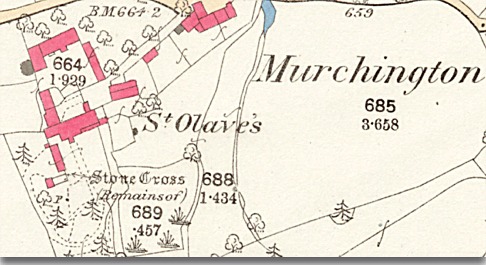
One of our crosses is missing – well it’s not actually missing it was just shunted some 45 kilometres around Devon from Bow to Murchington then to Down St. Mary. As always, whilst researching Murchington I was looking on the old 1906 OS 25 inch map when I spotted a ‘stone cross’ marked near one of the buildings at St. Olaves in Murchington. Originally St. Olaves was a simple farmstead which the rector of St. Olaves church in Exeter converted into a modest sporting and agricultural estate. Incidentally, it was reported that he once caused a riot at Exeter when he conducted a funeral service whilst three sheets to the wind. Anyway, that’s by the by, the question is how did the cross find its way from there to Down St. Mary?

In Chudleigh’s book of 1892 he mentioned that on his visit to Murchington he saw in the Rector’s garden at (at St. Olaves) and old cross placed against a wall and as can be seen below he was kind enough to make a sketch of the cross. This is one of the earliest literal acknowledgements of the cross and was shortly followed up by William Crossing’s account which reads: “A few years ago, in the garden of St. Olave’s, a pleasantly situated residence, then belonging to the Rev. W. T. A. Radford, rector of Down St. Mary, was a fine old cross. It was not a Dartmoor cross, having been brought from the parish of Bow, (where it was found serving as a paving stone) which is many miles distant. This was done, I have been informed, by the Rev. J. Ingle, a former owner of the property. About three years ago, Mr. Radford sold St. Olaves to the Rev. A. G. Barker, and shortly afterwards the rector of Down St. Mary, saying that Mr. Radford had authorised him to remove the cross, took it away to his own parish, and placed it in the churchyard there, where it is now.” – Crossing, p.134.
The above quotation is uncharacteristically confusing from William Crossing, basically it was the Rev. Ingle who first brought the cross to St. Olaves. It was Mr. Radford who was the then rector of Down St. Mary and it was after his death that his successor, the Rev. R. Kentish Cornish had the cross removed to Down St. Mary sometime between 1897 and 1909.
For those into vital statistics – today the cross resides in a socket stone measuring 0.68m square and octagonally chamfered on top. Each side of the octagon measures 0.32m and stands at a height of 0.31m. It is thought this base dates to around 1900. The cross itself was fashioned from a single piece of granite and is described as being crudely carved. The cross has a height of 1.74m and the asymmetrical arms span to 0.57m. The cross also displays pyramid stops which become octagonal. It has been suggested that the cross was medieval in origin and on the 20th of November 1986 was classified as a Grade II listing.

So there it is, the question being can this be classified as a Dartmoor cross? Well, through no fault of its own it was brought to reside on Dartmoor for a brief period and was certainly marked on the early OS map. Therefore in order to record its lineage I would suggest that it just scrapes through into the annals of Dartmoor’s history albeit for a short spell. I often wonder why some of Dartmoor’s ancient stone crosses end up in the properties of the ‘worthies’? Was a simple case of preservation or perhaps as what was conceived as a prestigious garden feature?

Chudleigh, J. 1897. An Exploration of Dartmoor’s Antiquities. Kent: J. Pegg Publishing.
Crossing, W. 1987. The Ancient Stone Crosses of Dartmoor. Exeter: Devon Books.
 Legendary Dartmoor The many aspects past and present of Dartmoor
Legendary Dartmoor The many aspects past and present of Dartmoor
